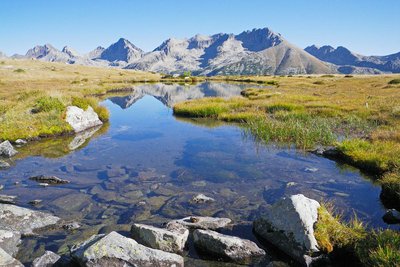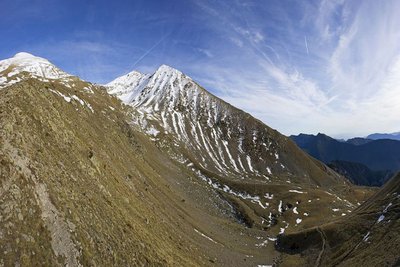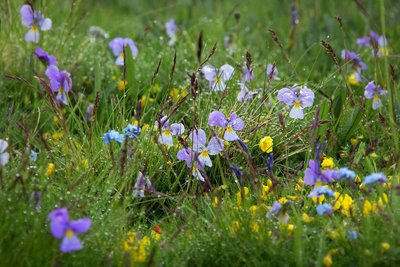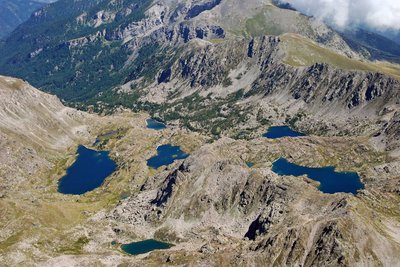
Lacs des Millefonts
5 points of interest

Le lac Barnon au pied de la cime Barnon, (2379), dans le vallon de Mollières en fin d'été, En fond, la Tête du Claus, (2897 m). - RIFFLET François  Geology
GeologyThe geology of the Mercantour
The site of Col de Veillos is marvellous for a geological reading of the landscape.
The rocks of the col form this singular relief, known as “ruiniform”. They are rauhwackes, of sedimentary origin. On the road to the Millefonts carparks, you may already have spotted the beautiful limestone piton of Baus de la Frema.
Opposite Col de Veillos, the ridge at the north, between the cols of Ferrière and Barn, is made up of crystalline metamorphic rocks: migmatite, with a mixture of light and dark colours.
And from Col de Barn, enjoy the view across Argentera and its famous granite.
Point de vue (sud, sud-est), depuis le col de Veillos (2194m) - GR52 - Circuit des lacs de Millefonts. - ANCELY Mathieu  Pastoralism
PastoralismMountain pastoralism
On this immense Alpine pasture of Millefonts, the flocks settle in for the summer. According to the season, we can see many sheep here (destined for meat) as well as goats.
The big dogs whose job it is to defend the flocks against any attacks from predators (stray dogs, wolves...), are Pyrenean Mountain Dogs. If they approach you, stay calm and do not move. After they have looked at you for a while, they will quickly head back off to protect the flocks. These dogs are of great help to the shepherds.
Détail d'une prairie fleurie, pensées des Alpes (Viola calcarata), également appelées pensées éperonnées. - GOURON Claude  Flora
FloraAlpine grasses
In the mountains, the rough climatic conditions (cold, wind...) prevent the forest from growing beyond an altitude of 2200 metres. Above this level, only grasses resist. Although it may appear rough and homogeneous, this ecosystem is actually extremely rich. Beyond the multiple plant species (such as carlina, lotus, blue gentian, clover, etc.), there are many insects (such as the famous Siberian cricket), mammals (marmots, voles, stoats) and birds (rock ptarmigans and rock partridges).
Marmotte des Alpes, (Marmota marmota), un marmotton assis - BLANC Jacques  Fauna
FaunaMarmots (marmotta marmotta)
Between screes and Alpine pastures, you can see – and more easily hear – marmots, delightful rodents which are typical of the mountain environment.
When you hear one emit its high call, look to the sky: it is perhaps the marmot’s worst enemy, the golden eagle, soaring above…
Genuine hibernators, marmots spend half the year sleeping tin their burrows. They can weigh up to 6kg before winter, making them walk somewhat heavily even if they retain their natural agility.
lac Fourca, lac Long Supérieur, (2111 m), le vallon de la Minière à Tende - GOURON Claude  Geology
GeologyThe life and death of mountain lakes
The landscape of the grassland and the Millefonts lakes is the direct result of the geographical model put in place by the last glacial period. The glaciers created deep hollows in places and in other created natural dams called. The two phenomena naturally created mountain lakes. However, sediment and organic plant matter tend to fill the lakes in, leaving just a wet and marshy area: the peat bog.
These environments are very rich in plant life but also highly fragile. An excellent example can be see downstream of the small Millefonts lake.
Description
From the carpark at Millefonts, go up path GR52 (red and white markers) which initially leads to the Col de Veillos, from where you can see the entirety of the valley.
Go past a path which heads off to the left.
After a steep climb, you will see a shepherd’s hut on the right. The itinerary continues towards the bottom of the valley, following the western slopes of Mont Pépoiri, amid the Alpine meadows.
Below, you will see the first lake, which is oddly called «Lac petit» despite being the biggest of the five Millefonts lakes.
The path then crosses an area of rocky scree and Alpine pastures. The climb then continues unhindered via a stony path which successively overlooks Lac Rond, Lac Long and Lac of the Millefonts lakes, finally arriving at the Col du Barn (2 452m).
A view over the delightful Barn valley and the Argentera chain, the highest peak of these mountains (3297m).
At the Col du Barn, the green hexagons, which can be seen on the rocks all along the crest, denote the boundary of Mercantour National Park. They are not markers for a hiking itinerary!
Follow the same route for the return journey.
- Departure : Carpark at Millefonts, Saint Dalmas Valbeblore
- Arrival : Carpark at Millefonts, Saint Dalmas Valbeblore
- Towns crossed : Valdeblore
Altimetric profile
Recommandations
Information desks
Maison du Parc national du Mercantour - Saint-Martin-Vésubie
8, Avenue Kellermann - Villa Les Iris, 06450 Saint-Martin-Vésubie
Horaires
Ouvert tous les jours sauf le dimanche du 15 juin au 15 septembre
Office de Tourisme Métropolitain - Bureau d'information de la Bollène-Vésubie
Place du Général de Gaulle, 06450 La Bollène Vésubie
Horaires
Du 01/01 au 31/12, tous les lundis, mardis, mercredis, jeudis et vendredis de 9h à 17h.Fermetures exceptionnelles les 1er janvier, Lundi de Pâques, Jeudi de l'Ascension, Lundi de Pentecôte, 1er mai, 8 mai, 14 juillet, 15 août, 1er novembre, 11 novembre et 25 décembre.
De 9h00 à 12h00 et de 13h00 à 17h00.
Access and parking
Parking :
Report a problem or an error
If you have found an error on this page or if you have noticed any problems during your hike, please report them to us here:
